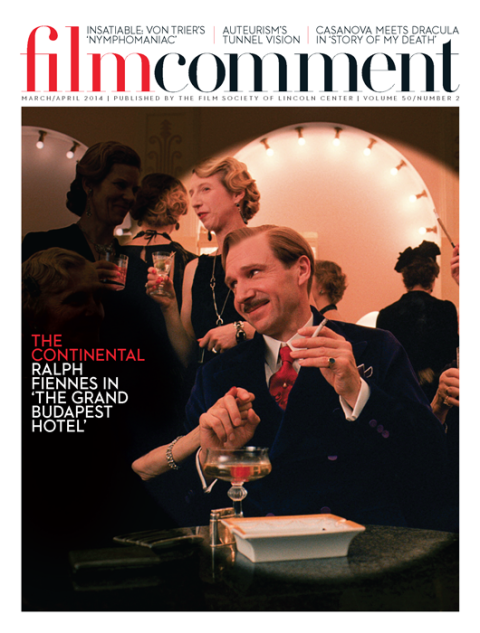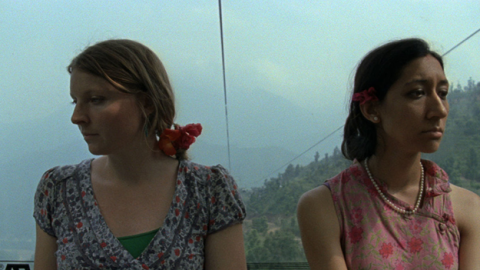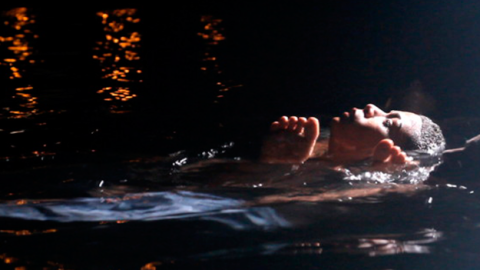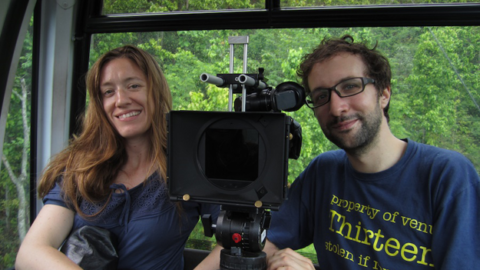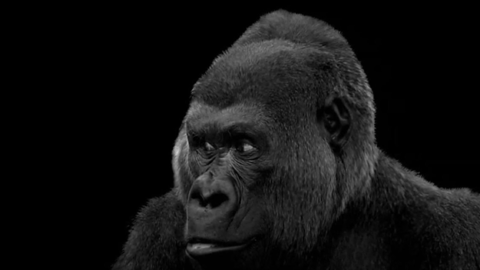“Where are we to put the limit between the body and the world, since the world is flesh?”
—Maurice Merleau-Ponty, The Visible and the Invisible

Manakamana
Two feature-length nonfiction films that couldn’t be more radically different, Leviathan and Manakamana are visually stunning cinematic works of what one might (or might not) call ethnography. Lucien Castaing-Taylor and Véréna Paravel’s Leviathan (12) throws us into a tumultuous journey on a commercial fishing boat off the coast of New Bedford, Massachusetts; Stephanie Spray and Pacho Velez’s Manakamana (13), on the other hand, gently transports us by cable car, up, up, up and then down, down, down a Nepalese mountain that is home to a Hindu temple, long a site of pilgrimage. While Leviathan is constructed primarily from footage captured by dozens of GoPro digital cameras that were attached, thrown, swung, and recovered from a number of diverse vantage points, Manakamana is shot with a tripod-mounted Super-16 camera that has an almost totemic significance because it once belonged to Robert Gardner, the ultimate bad boy of ethnographic filmmaking and founding director of Harvard’s Film Study Center. While Leviathan focuses on the visceral, violent collision between nature and culture, animal and human, flesh and muscle as food and as labor, Manakamana attends to the smallest of gestures of its travelers up and down the mountain in order to engage us in an exploration of the mysteries and revelations of communication and culture.
What then links these as well as the other films made under the aegis of Harvard’s Sensory Ethnography Lab? Its website notes “innovative combinations of aesthetics and ethnography” and attention to dimensions of the animate and inanimate world that are not readily “rendered with propositional prose.” In an interview with Scott MacDonald published in the Fall 2013 issue of Framework, Lucien Castaing-Taylor, founder of the Sensory Ethnography Lab and Harvard faculty member (in the departments of Anthropology and Visual and Environmental Studies), notes that the SEL, as it is commonly referred to, is concerned with the effort “not to analyze, but to actively produce aesthetic experience, and of kinds that reflect and draw on but do not necessarily clarify or leave one with the illusion of ‘understanding’ everyday experience.” The website’s description has a determined and explicit bias: the SEL “opposes the traditions of art that are not deeply infused with the real, those of documentary that are derived from broadcast journalism, and those of visual anthropology that mimic the discursive inclinations of their mother discipline.”
The choice of SEL’s name falls within the lineage of a current in written anthropological scholarship that emerged in the late Eighties and Nineties. These methodological approaches as defined by different anthropologists—Paul Stoller’s “sensuous scholarship,” Michael Jackson’s “radical empiricism,” and Robert Desjarlais’s “knowing through the body”—each insist on the crucial role of the body and the senses, the visceral and the palpable, in any engagement with and representation of the world. The philosophy of SEL also echoes an older debate among various practitioners of ethnographic film about the respective roles of verbal explanation versus experience, propositional knowledge versus corporeal knowledge, and the dangers or effects of aesthetics in any ethnographic representation. Instigated in part by the innovative and boundary-pushing work of Gardner, Jean Rouch, and filmmaker and author David MacDougall (who also briefly taught at Harvard), this debate still persists to a certain degree. As Gardner once dryly commented regarding the criticism of his work by anthropologists: “The emptiness of this hapless genre [ethnographic film] is perpetuated in endless, solemn debate by social scientists, arguing, finally, for nothing other than a cinema bereft of aesthetic concerns.”

Leviathan
For most of the SEL filmmakers, “aesthetic concerns,” as in the serious attention to the philosophical and experiential force of cinematic form, are crucial. This is most notable in Manakamana and Leviathan (and in Castaing-Taylor’s video installations as well), and it accounts for these films’ extremely enthusiastic reception from festivalgoers, critics, and museum curators. Indeed, Leviathan has been said to “look and sound like no other documentary in memory” (Dennis Lim) and to create an experience that is “entirely new in the annals of modern theatrical cinema” (MacDonald). The fervent critical response to Leviathan pulled the entire Sensory Ethnography Lab oeuvre into the limelight, even though some films with the SEL imprimatur had already been quite successful in their own right, especially Castaing-Taylor and Ilisa Barbash’s Sweetgrass (09) and Paravel and J.P. Sniadecki’s Foreign Parts (10). In the last two years the SEL has been heralded as a unique entity and voice in the world of documentary film (unlike Harvard’s undergraduate filmmaking program, where the directors of three of this year’s Oscar-nominated documentaries studied).
Leaving aside the multiple and potentially contentious definitions of what constitutes filmed ethnography, one might agree with MacDonald that many of the SEL films partake in a “cinema of place.” The Sensory Ethnography Lab provides courses and resources, and supports the work of graduate students in various departments, especially anthropology. Thus two of its most prolific graduates, Sniadecki and Spray, have shot many of their audiovisual works in their respective field sites, China and Nepal. Both filmmakers focus on portraying the gestures and interactions of everyday life, with Sniadecki’s works more likely to explore the dynamics engendered by and in a specific public space (a riverbank, a demolition work site, a public park), while Spray’s work delves into the daily lives and relationships of particular individuals in an extended family. Their ease and familiarity with the people they are filming is palpable in all of their work. Spray’s early films—Kale and Kale (07), Monsoon-Reflections (08), and As Long As There’s Breath (09)—while somewhat more conventional in their observational approach, manifest an exceptional delicacy and gentleness through her compositions, the positioning of her own body and gaze among her subjects (rather than “at” them), and the way an occasional exchange of glances or utterance brings forth a sense of intimacy. They are among the highlights of the SEL productions, but far less well known than those set in the U.S., such as Sweetgrass and Foreign Parts.
These latter two works are award-winning feature-length documentaries that examine activities and social formations which, at the end of each film, are revealed to be on the verge of disappearing. Shot mostly before the SEL was founded in 2006, Sweetgrass, along with the installation works that were created from extensions of the same footage, is nevertheless a seminal film for the lab. Like the later Leviathan, it was also inspired by the confrontation of human, animal, and larger forces of nature, here played out between three thousand sheep, a handful of sheepherders, their horses and their dogs as they make their way over three months through Montana’s Absaroka-Beartooth mountains. Castaing-Taylor, in an interview with MacDonald, talks about seeking “to anthropomorphize sheep and simultaneously to bestialize humanity.” This desire to relativize the human, to suggest a “kind of restless ontological parity” between the human and non-human, is an equally crucial element in Leviathan. Indeed, while the idea of creating a “post-humanist” vision is something that more than one SEL filmmaker alludes to, it is only in Castaing-Taylor’s works that one sees its possible inaugural enactments. In Sweetgrass it is suggested by the camera’s mobility, its frequent proximity to the sheep and what one might understand as their vantage point, as well as the vast panoramas that situate both sheep and men in an immense, seemingly intractable and indomitable natural world. We are thrown into this world without verbal explanation, as in most observational documentaries.

Sweetgrass
Intrinsic to the SEL aesthetic is a close attention to the expressive potential of sound; and as is the case with most SEL films, the careful and complex soundtrack was constructed by sound artist and lab co-director Ernst Karel. In Sweetgrass’s sound-rich natural world of taciturn men and noisy creatures we get sudden and startling moments of human auditory intimacy. The inclusion of sync-sound from radio mikes in shots where the subject is a mile or more away from the camera provides an estranging sense of entering into a sheepherder’s stream of consciousness, eavesdropping on semi-verbal monologues to himself, a horse, a sheep. This occasionally jarring and paradoxical relationship between the immensity of the seen world and intimacy of the heard mouth and throat is among the film’s most memorable qualities.
Paravel and Sniadecki’s Foreign Parts explores a lively community of used-car-part dealers, both longtime and newly arrived residents living among or even inside the vehicles, and what appears to be a thriving junkyard economy at Willets Point. The neighborhood lies in the shadow of the new baseball stadium in Queens which, over the course of the four seasons chronicled in the film, is gradually constructed and finally open to the public. Beginning with shots of the violent evisceration of a truck—guts, fluids, and all—the film becomes a moving portrait of idiosyncratic characters and the force of community in the midst of a profusion of carefully dissected and categorized automobile detritus. Unique in its presentation of fully rendered individuals who have gravitated by choice, chance, or necessity to this particular sector of the postindustrial subsistence economy, Foreign Parts, like many of the early SEL films, is a beautifully shot observational film. As in the works of Sniadecki and Spray, a sense of mutual generosity and occasional intimacy between filmmakers and subjects creates an affective texture that pervades the tone of the overall film. While centered on place in physical, material, and social terms, Foreign Parts
The last couple of years have led to more formal experimentation from the SEL filmmakers discussed here. Whether or not this is due to the SEL’s regular exchanges with students and faculty from Cal Arts, or the influence of specific figures like James Benning, Sharon Lockhart, and even Wang Bing with his tenacious focus on the laboring (and in turn resting) body, is impossible to say. Sniadecki’s most recent film, Yumen (13), co-directed with Huang Xiang and Xu Ruotao, is a carefully choreographed and strikingly shot hybrid work set in a semi-abandoned oil town in northwestern China, while People’s Park (12), which Sniadecki co-directed with Libbie D. Cohn, is a single-take film just short of 80 minutes in length, shot from a moving wheelchair in an urban park in Chengdu. Although an interesting portrait of the diversity of life and activities in the park, it is also (to this viewer) an example of form either eclipsing or too tenuously connected to subject matter, in spite of the analogy to Chinese scroll painting. Spray and Velez’s Manakamana, on the other hand, uses the principle of the single camera roll take (10 minutes in duration) to create a formally rigorous, crosshatched portrait of contemporary Nepalese society.

Manakamana
Constructed from a series of trips first up the mountain and then back down into the valley, the entirety of Manakamana is shot within the cable car, with a fixed frame that faces the passengers (from one to three people) and incorporates the landscape as seen through the windows. There is only one instance in which we meet a pair who first go up and later come back down. Beginning in the dark, then moving with the car out of the station, we discover we are with a man and a child, facing us, occasionally looking out the windows at the land below as they (and we) go upwards, perhaps aiming a quick furtive glance toward what may be a camera. Neither speaks. We are left to our own devices as to what to observe: the landscape beyond them, their body language, their expressions toward each other as we try to figure out their relationship, their sense of being observed as we wonder whether the camera is concealed or in plain sight.
With each set of passengers our experience of the space and those traveling within it deepens. Although no words are spoken until about 20 minutes in, we glean clues and information from what the passengers are carrying, how they sit, and later what they talk about—their relationships, their wishes, their reflections on a time before the cable car was built, and their emotional responses to the journey up or down. It is only gradually that we realize that the cable car leads to an important shrine, that the various subjects have distinct motivations and are bringing different offerings to the goddess, that some are less self-conscious than others, that perhaps the filmmakers—never explicitly acknowledged—were even involved in recruiting the pilgrims. The sequencing of the journeys is carefully constructed so that perspicacious and patient viewers are engaged in a constant process of discovery. While familiarity with Spray’s earlier work broadens the experience of watching Manakamana, in either case it is deeply engaging as we put all our senses to work to understand the world we have entered. The formal rigor and elegance of this piece make it unique in the SEL oeuvre, as does the seeming dislocation of the camera’s gaze. As a viewer we are not sure who or what is looking, how present the recording apparatus is to the subjects, and what their engagement is with the camera and the people behind it, if any. It is only through subtle hints in the texture of the image and the comments of the passengers that we slowly come up with hypotheses.
This question of the location of the gaze is, of course, absolutely central to Leviathan as well. It deliberately dislocates us, but to a different end, using different tools, and to create a radically different experience. The overwhelmingly immersive qualities of the film are constructed partly through the use of the small GoPro cameras that the filmmakers attached to the bodies of men at work and rest and to various spots inside and outside the vessel as the sea churns, insistently pushing forward, and sweeping up fish in its nets, spewing out blood and guts in its wake. We frequently become disoriented, try to find our bearings as we surface and are submerged again and then resurface, or as we follow the gestures and gaze of the fishermen as they work frenetically amid the glare of lights in the night and the din of machinery. At the turbulent threshold of sea and night sky, or the liminal spaces between man and prey, man and machine, we’re engulfed by the musique concrète of motors, winches, men, gulls, and the elements. If any of the SEL films creates a “post-humanist” vision, it is this one. Although this goal may seem at odds with a cinema that seeks grounding in the senses, Leviathan simply extrapolates “sensory” from the human body to the body of the world itself—to the bodies of matter, nature, economic exploitation, etc. Although Castaing-Taylor has referred to Heidegger in discussing the philosophical implications of some of his film work, Leviathan feels like a gesture toward what Schopenhauer calls the “will,” as opposed to our normal and normalized world of representations. Leviathan seems to make that “will” palpable.
In experiencing the film, at times I wondered at the hubris of attempting to create such a vision, a vision that seems to see the human as merely the embodiment of labor, that looks at men much like the creatures of the sea and air, busy doing what we do as a species: working, washing, gathering food, resting in front of images of ourselves (on television), squawking, communing, adorning ourselves (the camera’s interest in the men’s tattoos seemed a bit prurient—or perhaps it was just my own prurience at work). Ultimately, however, the film’s grand gestures, both visual and auditory—its generosity toward the flow of time and water and air, toward hungry birds and dying fish, toward the power of machines that have made our world what it is today—overwhelm my doubts. Remembering the petty insignificance of human beings, I take solace in the realization Leviathan seems to suggest: that there is, ultimately, no clear boundary between body and world because, as Merleau-Ponty has said, the world is flesh.



